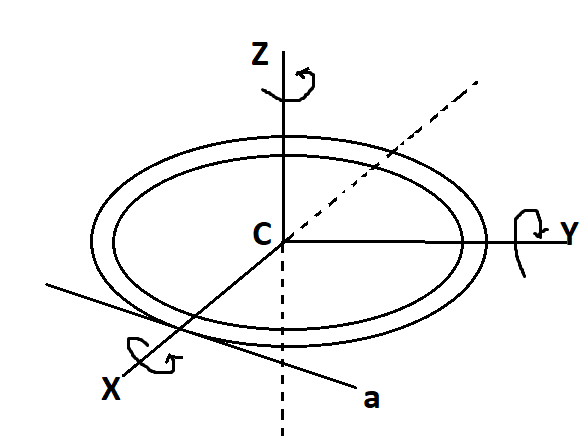
Answer
464.4k+ views
- Hint: Write the formula for moment of inertia of disc about its own axis. Calculate the moment of inertia about its diameter using the perpendicular axis theorem. Now use this formula of the moment of inertia of a disc about its diameter to calculate the moment of inertia about a tangential axis using parallel axis theorem.
Complete step-by-step solution -

The moment of inertia about the z-axis is given by ${{I}_{z}}$ which is passing through the center of mass and perpendicular to the plane is given by ${{I}_{z}}={{I}_{c}}$. ${{I}_{x}}\And {{I}_{y}}$are moments of inertia of disc about diameter along x and y axes respectively.
Therefore by perpendicular axis theorem, we get
\[{{I}_{z}}={{I}_{x}}+{{I}_{y}}\]
But \[{{I}_{z}}=I\text{ and }{{I}_{x}}={{I}_{y}}={{I}_{d}}\]
Put the value we get,
\[\begin{align}
& I=2{{I}_{d}} \\
& {{I}_{d}}=\dfrac{I}{2} \\
\end{align}\]
\[\begin{align}
& \text{we know that moment of inertia about center of disc is }{{\text{I}}_{c}}=I=\dfrac{M{{R}^{2}}}{2} \\
& M{{R}^{2}}=2I \\
\end{align}\]
We know that moment of inertia about a is ${{I}_{a}}$. Now by using parallel and perpendicular axis theorem.
We have,
$\begin{align}
& {{I}_{a}}={{I}_{y}}+M{{R}^{2}} \\
& {{I}_{a}}={{I}_{d}}+M{{R}^{2}} \\
& {{I}_{a}}=\dfrac{I}{2}+2I=\dfrac{5}{2}I \\
\end{align}$
Moment of inertia about a tangential axis in its plane is $\dfrac{5}{2}I$
Additional Information:
Perpendicular axis theorem states that moment of inertia of a plane lamina about an axis perpendicular to its plane is equal to the sum of its moment of inertia about two mutually perpendicular axes concurrent with perpendicular axis and lying in the plane of the laminar body.
Parallel axis theorem states that moment of inertia about of a body about any axis is equal to the sum of its moment of inertia about a parallel axis passing through its center of mass and product of its mass and square of the perpendicular distance between the two parallel axes.
Hence, option (A) is correct.
Note: Moment of inertia of disc about x and y-axis are the same only in case of the disc. Note that the thickness of the disc should be uniform. Do not get confused between the theorem of parallel axis and the theorem of perpendicular axis theorem. Moment of inertia about a tangential axis depends on the mass of disc, the radius of disc or diameter as well as a moment of inertia of disc about center.
Complete step-by-step solution -

The moment of inertia about the z-axis is given by ${{I}_{z}}$ which is passing through the center of mass and perpendicular to the plane is given by ${{I}_{z}}={{I}_{c}}$. ${{I}_{x}}\And {{I}_{y}}$are moments of inertia of disc about diameter along x and y axes respectively.
Therefore by perpendicular axis theorem, we get
\[{{I}_{z}}={{I}_{x}}+{{I}_{y}}\]
But \[{{I}_{z}}=I\text{ and }{{I}_{x}}={{I}_{y}}={{I}_{d}}\]
Put the value we get,
\[\begin{align}
& I=2{{I}_{d}} \\
& {{I}_{d}}=\dfrac{I}{2} \\
\end{align}\]
\[\begin{align}
& \text{we know that moment of inertia about center of disc is }{{\text{I}}_{c}}=I=\dfrac{M{{R}^{2}}}{2} \\
& M{{R}^{2}}=2I \\
\end{align}\]
We know that moment of inertia about a is ${{I}_{a}}$. Now by using parallel and perpendicular axis theorem.
We have,
$\begin{align}
& {{I}_{a}}={{I}_{y}}+M{{R}^{2}} \\
& {{I}_{a}}={{I}_{d}}+M{{R}^{2}} \\
& {{I}_{a}}=\dfrac{I}{2}+2I=\dfrac{5}{2}I \\
\end{align}$
Moment of inertia about a tangential axis in its plane is $\dfrac{5}{2}I$
Additional Information:
Perpendicular axis theorem states that moment of inertia of a plane lamina about an axis perpendicular to its plane is equal to the sum of its moment of inertia about two mutually perpendicular axes concurrent with perpendicular axis and lying in the plane of the laminar body.
Parallel axis theorem states that moment of inertia about of a body about any axis is equal to the sum of its moment of inertia about a parallel axis passing through its center of mass and product of its mass and square of the perpendicular distance between the two parallel axes.
Hence, option (A) is correct.
Note: Moment of inertia of disc about x and y-axis are the same only in case of the disc. Note that the thickness of the disc should be uniform. Do not get confused between the theorem of parallel axis and the theorem of perpendicular axis theorem. Moment of inertia about a tangential axis depends on the mass of disc, the radius of disc or diameter as well as a moment of inertia of disc about center.
Recently Updated Pages
Who among the following was the religious guru of class 7 social science CBSE

what is the correct chronological order of the following class 10 social science CBSE

Which of the following was not the actual cause for class 10 social science CBSE

Which of the following statements is not correct A class 10 social science CBSE

Which of the following leaders was not present in the class 10 social science CBSE

Garampani Sanctuary is located at A Diphu Assam B Gangtok class 10 social science CBSE

Trending doubts
Which are the Top 10 Largest Countries of the World?

In what year Guru Nanak Dev ji was born A15 April 1469 class 11 social science CBSE

A rainbow has circular shape because A The earth is class 11 physics CBSE

How do you graph the function fx 4x class 9 maths CBSE

Fill the blanks with the suitable prepositions 1 The class 9 english CBSE

In Indian rupees 1 trillion is equal to how many c class 8 maths CBSE

The Equation xxx + 2 is Satisfied when x is Equal to Class 10 Maths

Why is there a time difference of about 5 hours between class 10 social science CBSE

Difference between Prokaryotic cell and Eukaryotic class 11 biology CBSE




